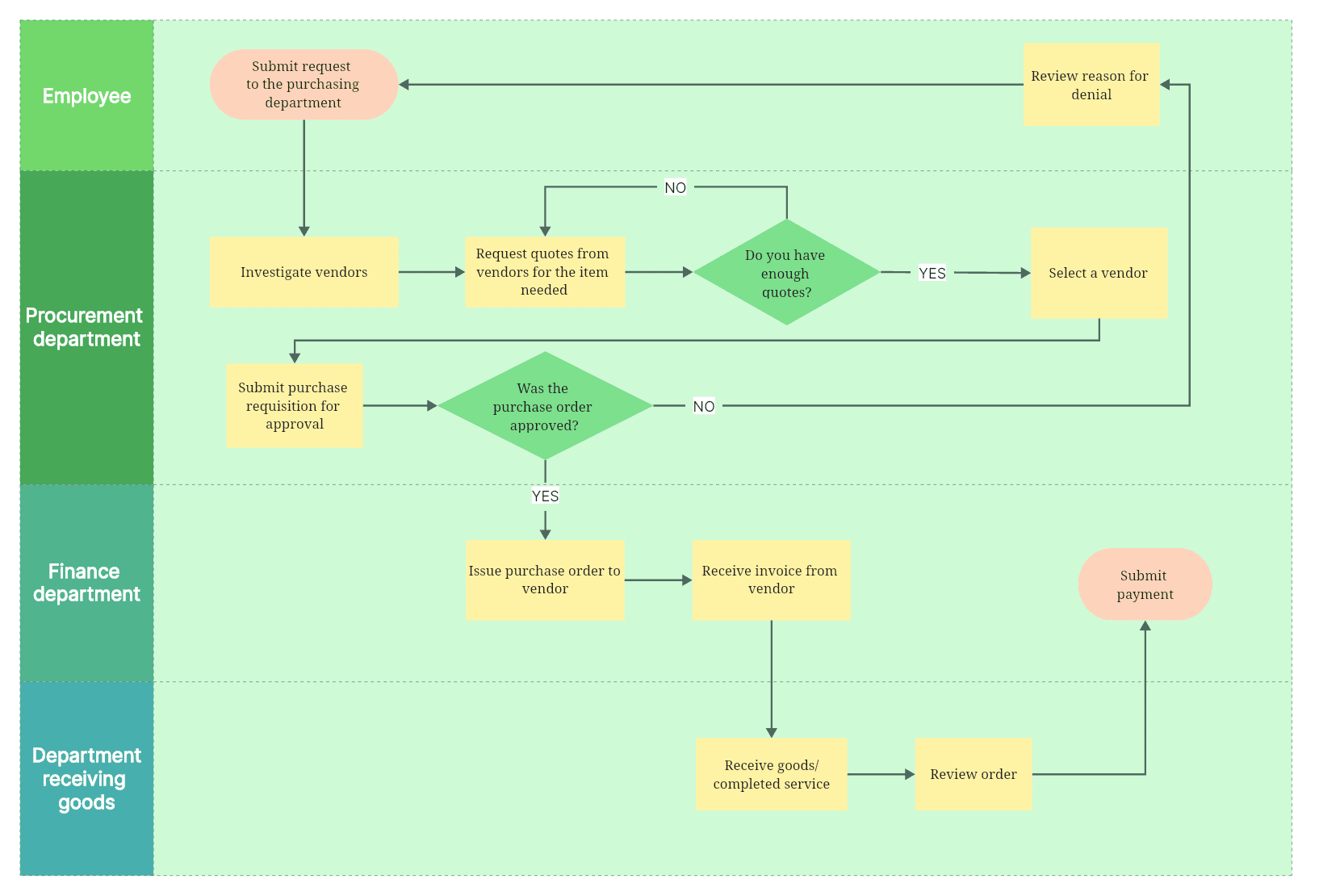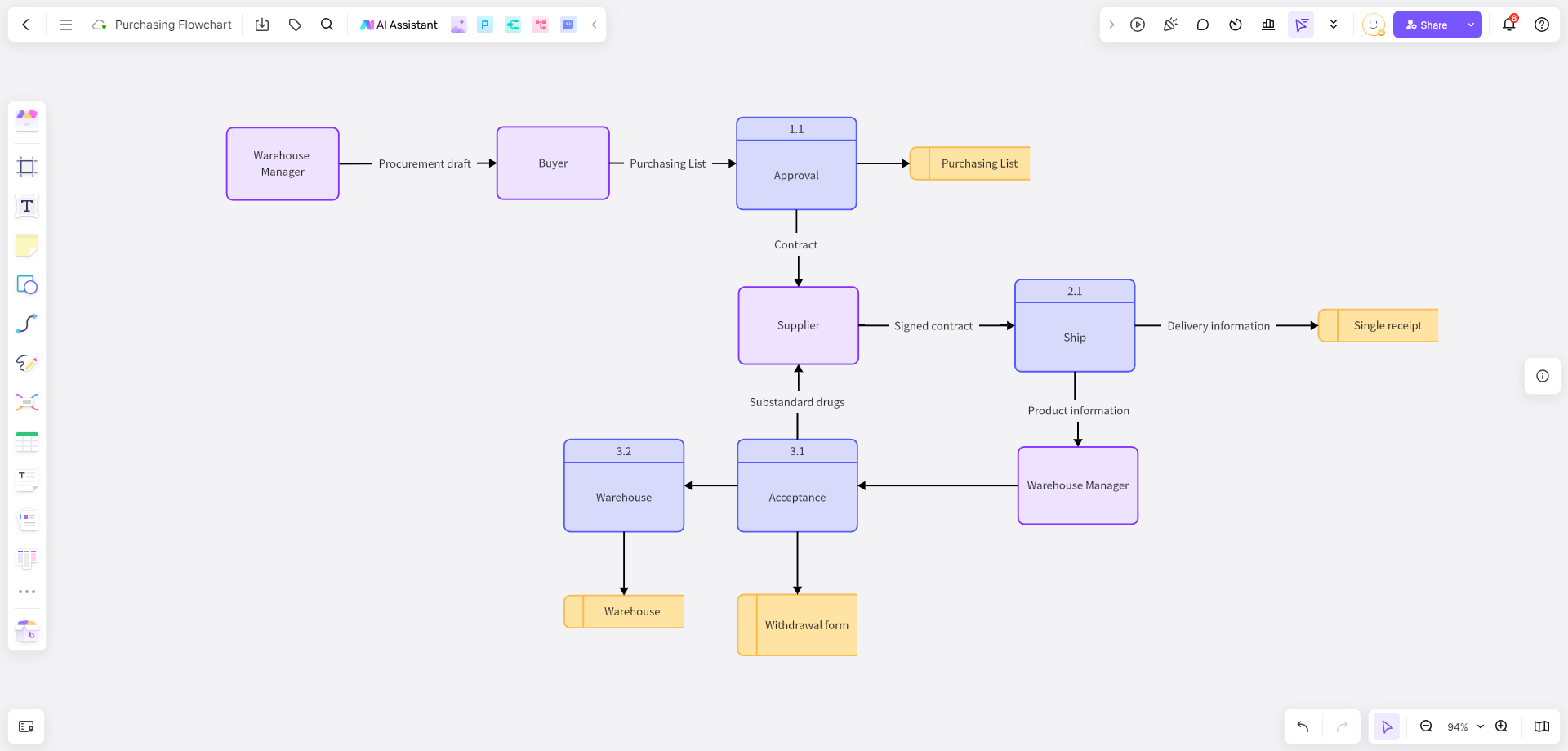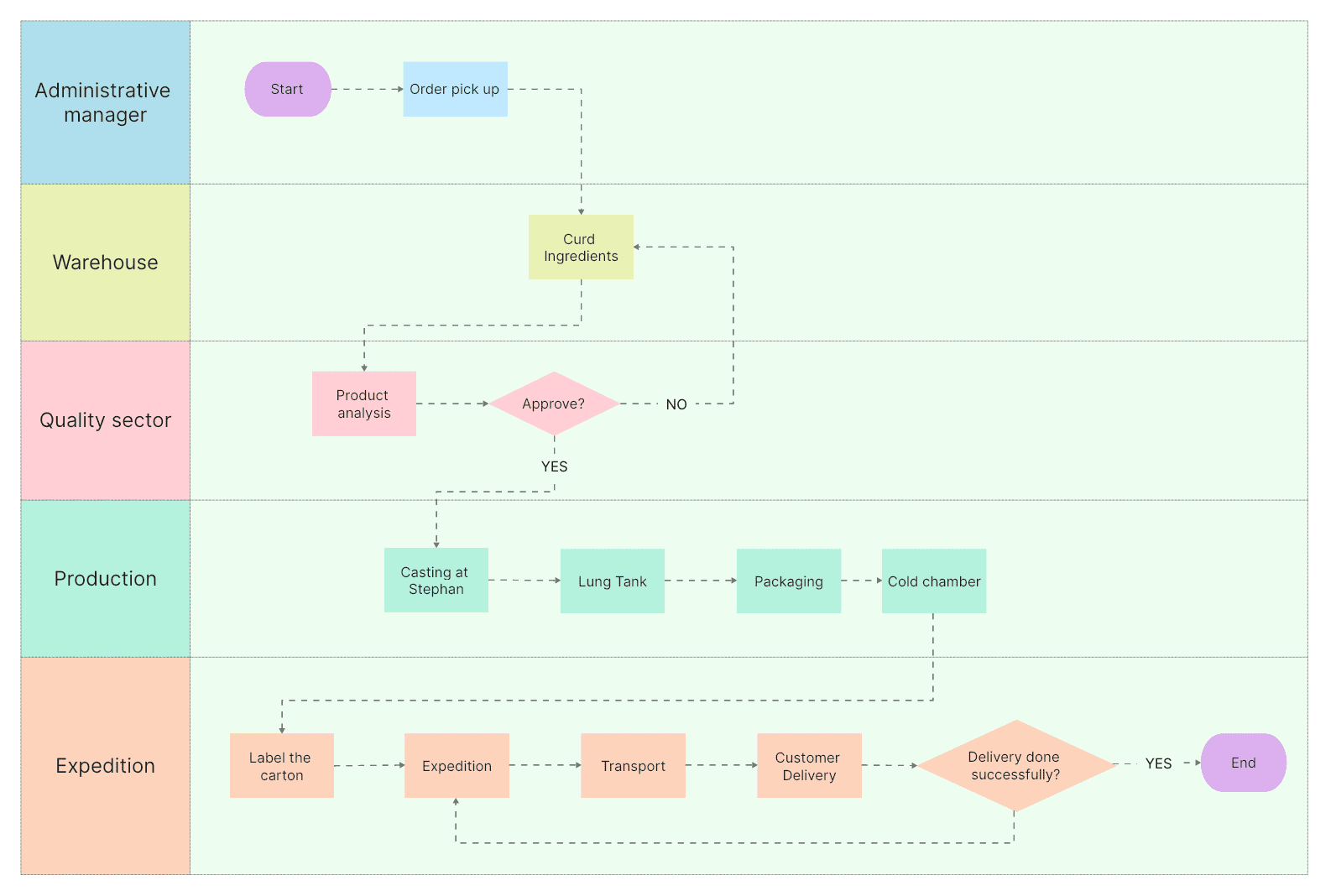Understanding the nuances of your organization's purchasing and procurement operations is pivotal for its effective management. A purchasing & procurement process flowchart is an invaluable tool for elucidating this intricate process. Let's delve into the particulars of this aspect and why it is integral to your organization.
What is Procurement Process Flow?
The procurement process flow refers to the sequential steps that an organization undertakes when procuring goods or services. It encapsulates all stages of a procurement journey, from identifying needs and sourcing suppliers to contract negotiations, delivery, and evaluation.
While the specifics of this flow may vary from organization to organization, the aim remains consistent: acquire the necessary goods or services in a timely, cost-effective, and efficient manner.

Types of Procurement Process
Procurement is not a monolithic process; different procurement types come into play based on various factors. Understanding these variations can aid in deciding the best approach for your organization's needs.
1. Direct Procurement Process
This type primarily deals with purchasing raw materials or goods directly used in the production of products or services. Direct procurement is mission-critical as it directly affects the production process and impacts the company's bottom line.
2. Indirect Procurement Process
Indirect procurement refers to acquiring goods or services not directly involved in production but essential for day-to-day operations, like office supplies, cleaning services, or software subscriptions. While not directly linked to production, efficient management of indirect procurement can result in significant cost savings.
3. Service Procurement Process
Service procurement relates to procuring professional services that are crucial for an organization's operations. This might include legal services, consulting, marketing, IT services, among others. It's vital to manage service procurement strategically since the quality and efficiency of procured services directly impact business performance.
What's the Difference between a Purchasing Process and a Procurement Process?
The terms purchasing and procurement are often used interchangeably, but they represent distinct processes within an organizational context.
The purchasing process is a subset of the broader procurement process. While purchasing focuses primarily on the transactional aspect of acquiring goods or services (like order placement, delivery, payment), procurement encompasses a broader strategic scope. It includes steps like vendor selection, contract negotiation, risk management, and relationship building – ensuring value maximization throughout the process lifecycle.
Why You Need a Flowchart for Purchasing & Procurement Process?
Navigating through these steps can become increasingly challenging without a well-structured system. Here's where a purchasing & procurement process flowchart becomes instrumental.
A process flowchat flowchart visually represents the sequential steps in a process, making it easier to understand and manage. By visually mapping out your purchasing & procurement operations, you can reap multiple benefits:
- Enhanced transparency: Gain a holistic view of your entire process, identify bottlenecks, inefficiencies, or weak links in the system.
- Streamlined operations: Establish clear, standardized procedures, reducing uncertainties and potential errors.
- Informed decision-making: Make data-driven decisions and predict trends by accurately tracing the flow of operations.
What Are the Three Key Components of the Procurement Process Flowchart?
When constructing a procurement process flowchart, three critical components should always be in focus: people, process, and paperwork. Understanding these components is fundamental to creating an effective and efficient flowchart.
People
At the heart of every procurement process are the people who bring it to life. They are the decision-makers, negotiators, and managers who identify needs, source suppliers, evaluate proposals, negotiate contracts, and ensure delivery.
Key individuals in a procurement process may include procurement officers, managers, financial analysts, contract specialists, and internal stakeholders from departments requiring procurement.
Understanding the roles and responsibilities of each of these individuals will greatly aid in the design of your procurement process flowchart. It is crucial to involve them in the creation process to accurately capture their tasks and decision-making authority at each step.
Process
The process refers to the sequence of steps undertaken during procurement, from identifying a need through to evaluation and feedback after delivery. It involves decision-making at various stages and requires a clear delineation of responsibilities.
Understanding the sequence and specifics of your organization's procurement process is crucial for designing an effective flowchart. A well-defined process contributes to smoother operations, increased efficiency, improved supplier relationships, and potential cost savings.
Remember, every organization's procurement process may vary based on its specific needs, size, industry regulations, and strategic goals. Therefore, your flowchart should be tailored to fit these unique circumstances.
Paperwork
The last but equally important component is paperwork. Documentation plays a critical role in the procurement process, ensuring transparency, compliance with internal policies and legal regulations, maintaining historical records for future reference, and facilitating audits.
The paperwork in procurement can include purchase orders, invoices, contracts, delivery receipts, and evaluation reports. In your flowchart, you'll need to identify where these documents come into play and who's responsible for their completion and approval.
While paperwork can be time-consuming and cumbersome, it is integral to the procurement process. Advances in technology have enabled many organizations to move towards digitizing this aspect - leading to increased efficiency and accuracy.
7 Steps to Create Your Purchasing & Procurement Process Flowchart
Creating a purchasing and procurement process flowchart may seem daunting, but following these comprehensive steps can help demystify the task.
Step 1: Identify the Steps in Your Procurement Process
The first step in creating a flowchart is to understand the specific processes involved in your organization's procurement. This should include all the tasks from start to finish, such as identifying needs, selecting vendors, negotiating contracts, making purchases, receiving goods or services, processing invoices, and maintaining records.
Every organization has unique operations; hence, it's crucial to adapt this list according to your context. Seek input from various team members who are part of the procurement process to ensure all stages are covered accurately.
Step 2: Sequence the Steps
After you've identified the necessary steps, you'll need to order them in sequence of how they are executed. This step might require input from different departments or individuals to ensure the sequencing aligns with the actual process flow.
Step 3: Choose Flowchart Symbols for Each Step
Flowcharts use standard symbols to depict various aspects of a process. Choosing suitable symbols for each step of your procurement process will enhance the readability and understandability of your chart. Some commonly used symbols are:
- Rectangles for actions or processes
- Diamonds for decision points
- Ovals for the start or end points
- Arrows to indicate the directional flow
Each symbol has a unique implication, so choose wisely.
Step 4: Draw the Flowchart
With all elements in place, it's time to bring your flowchart to life. Use a suitable flowchart maker like Visio, Lucidchart, or Google Drawings to start creating your chart. Begin with the starting point (usually marked by an oval), then proceed to add actions (rectangles), decisions (diamonds), and other elements as necessary. Don't forget to connect these using arrows that depict the flow direction.
Remember, your flowchart should be simple and clean. Avoid cluttering it with too many details.
Step 5: Validate and Review Your Flowchart
Once you've created your initial version of the flowchart, validate its accuracy by walking through it with a few members from different stages of the procurement process. They can confirm if you've depicted the process correctly or suggest amendments if needed.
Revise your chart based on feedback received and review it one last time before finalizing. This iterative process helps ensure that your final flowchart is an accurate and effective representation of your procurement process.
Step 6: Share and Implement Your Flowchart
After finalizing your flowchart, share it with relevant team members. Provide training sessions if required, to ensure everyone understands how to interpret the chart. Implement it as part of your procurement strategy and regularly update it as your process evolves.
By breaking down the task into these manageable steps, creating a procurement process flowchart becomes less daunting and more strategic. Remember that this flowchart is a dynamic tool - as your organization grows and changes, so should your flowchart. Regular reviews will keep it relevant and ensure it continues to be a valuable resource for your procurement process.

Visualizing Your Procurement Process with Boardmix
Purchasing & procurement flowchart process visualization using tools like Boardmix is a powerful way to manage your operations strategically. The clear visuals can help you streamline the process and spot potential bottlenecks or efficiencies.
We hope this guide will empower you to develop a detailed, well-structured purchasing & procurement process flowchart. Now it's time for you to wield this knowledge and revolutionize your procurement management strategy.








